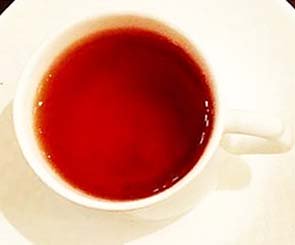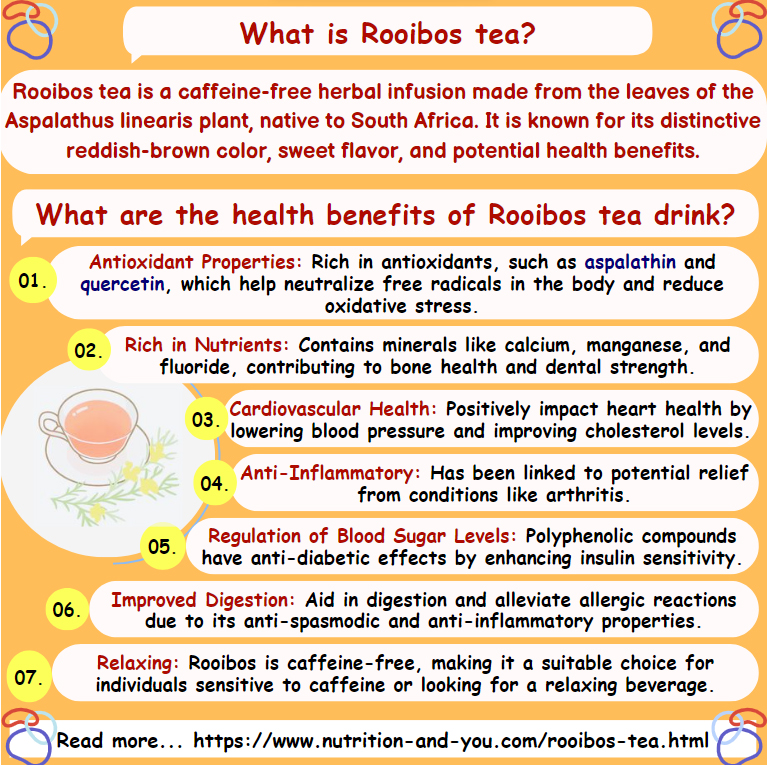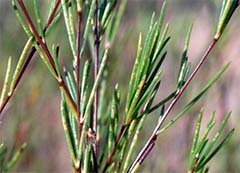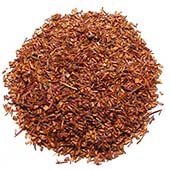Rooibos tea
Rooibos or red bush tea is an infusion obtained from the dried leaves and stems of a broom-like shrub native to the mountains of the Western Cape, South Africa. In 1772 the botanist Carl Thunberg first reported on the use of rooibos as a beverage from the local Khoisan people.
Botanically, the plant is a leguminous shrub. Scientific name: Aspalathus linearis.
 |
| Rooibos tea. Note rich ed color of the infusion. |
The Red bush plant is a hardy, drought-resistant plant and has a single basal stem that divides above the soil surface into multiple thin broom-like branches that carry bright green, needle-like leaves. The plant reaches a height of about 5-6 feet and a spread of about 3-5 feet.
The whole plant has a lifespan of 6 years. After about 18 months after the plantation, the plant is ready for harvesting when its branches are cut once a year about 50 cm above the ground.
Health benefits of Rooibos tea
Rooibos tea carries no calories and cholesterol. Nonetheless, this vibrant colorful infusion holds the best of the available antioxidants in nature.
Its needle-like leaves and light-brown stems carry powerful polyphenolic antioxidants known as chalconoids. These are aromatic phenols that give color and fruity fragrance to rooibos.
Important dihydro-chalcones in rooibos leaves are Aspalathin, a dihydrochalcone glucoside and Nothofagin, a phloretin glucoside. Research studies show that both these compounds exhibit antibacterial, antifungal, anti-tumor, and anti-inflammatory properties.
In addition, rooibos plant parts contain other important phenolic compounds in rooibos include flavones (orientin, isoorientin, vitexin, isovitexin, luteolin, chrysoeriol), flavanones (dihydro-orientin, dihydro-isoorientin, hemiphlorin) and flavonols (quercetin, hyperoside, isoquercitrin, rutin) (E.Joubert D.de Beer).
These phenolic compounds in the rooibos account for anti-diabetes, lowering LDL-cholesterol, oxidant stress reduction, and blood pressure regulation actions.
Medicinally, the infusion is known to reduce skin dryness, and pigmentation, and anti-wrinkle, and has soothing effects on skin and hair. Traditionally, the local inhabitants use its extraction to color their hair.
Moreover, rooibos tea is a caffiene-free drink. It has a calming effect on the nervous system, reduces heartbeat, and improves digestion.
Its leaves also carries trace amounts of minerals like iron, calcium, potassium, manganese, copper, and zinc.

|
| Principle | Nutrient Value | Percent of RDA |
|---|---|---|
| Energy | 1 Kcal | 0% |
| Carbohydrates | 0.20 g | <1% |
| Protein | 0 g | 0% |
| Total Fat | 0 g | 0% |
| Cholesterol | 0 mg | 0% |
| Dietary Fiber | 0 g | 0% |
| Vitamins | ||
| Folates | 1 µg | 0.25% |
| Niacin | 0 mg | 0% |
| Pyridoxine | 0 mg | 0% |
| Riboflavin | 0.004 mg | <1% |
| Thiamin | 0.010 mg | <1% |
| Vitamin A | 0 IU | 0% |
| Vitamin-C | 0 mg | 0% |
| Electrolytes | ||
| Sodium | 1 mg | <1% |
| Potassium | 9 mg | <1% |
| Minerals | ||
| Calcium | 2 mg | 0.2% |
| Iron | 0.08 mg | 1% |
| Magnesium | 1 mg | <1% |
| Zinc | 0.04 mg | 1<1% | Phyto-nutrients |
| Caffiene | 0 mg | -- |
Processing of rooibos tea
 |
| A. linearis. Note needle-like green leaves and light brown stems. |
After harvesting, rooibos leaves and stems undergo further treatment to obtain the end-use product which is ready for infusion as an herbal tea.
Fermentation: This process follows the same steps practiced by the local inhabitants, using traditional methods. Here, its needle-like leaves and stems are subjected to bruising and wetting with a sprinkling of water. The damp leaves are then allowed to ferment (sweating) for 12 hours. A process of enzymatic oxidation takes place during which the leaves change from green to a distinctive amber-red hue. Finally, the rooibos is spread out in the sun to dry.
Unfermented or green Rooibos: Here, the harvested leaves are sun-dried immediately, without the fermentation step, as in the preparation of green teas. It has a lighter color compared to traditional rooibos but composes relatively higher levels of phenolic antioxidants.
Harvesting and storage
 |
| Fermented red rooibos tea leaves. |
Similar to numerous other types of dried herbal teas, rooibos stands out as an exotic offering in the United States. For authenticity and quality, choose from novelty shops specializing in herbal tea products. Fermented red bush tea, as well as green types in containers and airtight packs, are put for sale in the supermarkets. Select superior-quality organic produce that is devoid of any heavy metals or pesticides.
At home, store in air-seal boxes away from sunlight and moisture. Use rooibos early as it loses flavor.
Preparation of rooibos tea
In its traditional bastions, rooibos leaves are directly added to water and boiled together in teapots for 10-15 minutes before straining under gentle heat.
Alternatively, pour on about 150 ml of hot water over 1 teaspoonful of dried leaves and allow to steep for 7-10 minutes and strain. Add some honey or sugar for the taste of the infusion. Rooibos has a fruity aroma and is appealing to all tastes since it contains little tannins, and therefore, less astringent.
Here are some other serving tips of rooibos:
Rooibos can be enjoyed up to 5-6 cups every day for long-lasting health benefits.
It can be consumed with milk, as rooibos latte.
Rooibos infusion can also blend well in smoothies, soups, and marinades as a flavoring and coloring agent.
Safety profile
There are no known reported cases of rooibos consumption toxicity. It can be used safely in children and pregnant women.(Medical disclaimer).
≺≺ Read Lemon balm tea health benefits
.≺≺ Back to Herbal teas from Rooibos tea. Visit here for an impressive list of all variety of herbal tea with complete illustrations of their nutrition facts and health benefits.
≺≺ Back to Home page.
Further Resources and reading:
South African Journal of Botany-E.Joubert D.de Beer. pdf. (opens in new window).